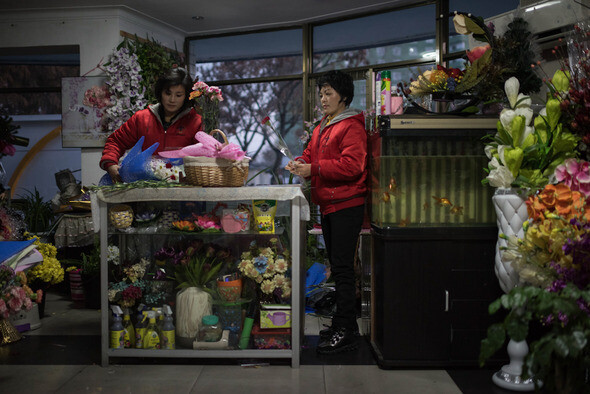hankyoreh
Links to other country sites 다른 나라 사이트 링크
North Korean economic growth surpasses South Korea’s for first time in eight years

North Korea’s economic growth rate for 2016 surpassed South Korea’s for the first time in eight years, Statistics Korea data show. But analysts predict its 2017 growth will be hindered by historic drought conditions and international economic sanctions.
A report on “Major North Korean Statistics Indicators for 2017” published on Dec. 15 by Statistics Korea estimated North Korea’s population at 24.9 million people, or roughly half South Korea’s population of 51.25 million. North Korea’s gross national income of 36.373 trillion won (US$33.5 billion) was approximately 1/45 that of South Korea (1.639665 quadrillion won/US$1.51 trillion).
Per capita gross national income was 1.46 million won (US$1,340), or around 1/22 the 31.98 million won (U$29,430) total for South Korea. North Korea’s growth rate last year was 3.9%, putting it ahead of South Korea’s 2.8%. It was the first time North Korea’s growth rate outpaced South Korea’s since 2008, when its rate was 3.1% to the South’s 2.8%. North Korea’s high growth rate for last year was attributed to a baseline effect after drought conditions in 2015 severely reduced food and power production, resulting in negative growth. But signs for the North Korean economy in 2018 are not encouraging.
“North Korea suffered its worst drought in 16 years this year, and with factors such as a reduction in trade with China due to international economic sanctions, most predictions have it unable to achieve a high growth rate like last year’s,” said Kim Gyu-cheol, a senior research fellow with the Korea Development Institute’s North Korean economy department.
North Korea’s mobile phone-subscribed population totaled 3,606,000 people, indicating that around 14 out of every 100 residents use a mobile phone. Total road length was 26,176 km, or roughly one-quarter South Korea’s 108,780 km, while total railway length was 5,226 km, or 1.3 times larger than South Korea’s 3,918 km. North Korea’s estimated total fertility rate for 2015–2020 was 1.94, falling below 2 for the first time but still outpacing South Korea’s 1.33.
By Heo Seung, staff reporter
Please direct questions or comments to [english@hani.co.kr]

Editorial・opinion
![[Column] Park Geun-hye déjà vu in Yoon Suk-yeol [Column] Park Geun-hye déjà vu in Yoon Suk-yeol](https://flexible.img.hani.co.kr/flexible/normal/500/300/imgdb/original/2024/0424/651713945113788.jpg) [Column] Park Geun-hye déjà vu in Yoon Suk-yeol
[Column] Park Geun-hye déjà vu in Yoon Suk-yeol![[Editorial] New weight of N. Korea’s nuclear threats makes dialogue all the more urgent [Editorial] New weight of N. Korea’s nuclear threats makes dialogue all the more urgent](https://flexible.img.hani.co.kr/flexible/normal/500/300/imgdb/original/2024/0424/7317139454662664.jpg) [Editorial] New weight of N. Korea’s nuclear threats makes dialogue all the more urgent
[Editorial] New weight of N. Korea’s nuclear threats makes dialogue all the more urgent- [Guest essay] The real reason Korea’s new right wants to dub Rhee a founding father
- [Column] ‘Choson’: Is it time we start referring to N. Korea in its own terms?
- [Editorial] Japan’s rewriting of history with Korea has gone too far
- [Column] The president’s questionable capacity for dialogue
- [Column] Are chaebol firms just pizza pies for families to divvy up as they please?
- [Column] Has Korea, too, crossed the Rubicon on China?
- [Correspondent’s column] In Japan’s alliance with US, echoes of its past alliances with UK
- [Editorial] Does Yoon think the Korean public is wrong?
Most viewed articles
- 1‘We must say no’: Seoul defense chief on Korean, USFK involvement in hypothetical Taiwan crisis
- 2Will NewJeans end up collateral damage in internal feud at K-pop juggernaut Hybe?
- 3[Column] Park Geun-hye déjà vu in Yoon Suk-yeol
- 4Why Korea shouldn’t welcome Japan’s newly beefed up defense cooperation with US
- 5Thursday to mark start of resignations by senior doctors amid standoff with government
- 6N. Korean hackers breached 10 defense contractors in South for months, police say
- 7[Guest essay] The real reason Korea’s new right wants to dub Rhee a founding father
- 8[Column] ‘Choson’: Is it time we start referring to N. Korea in its own terms?
- 9Kim Jong-un expressed ‘satisfaction’ with nuclear counterstrike drill directed at South
- 10[Editorial] New weight of N. Korea’s nuclear threats makes dialogue all the more urgent